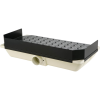- Joined
- Aug 28, 2011
- Messages
- 1,600
The handle is very close to the shape I want. It mostly needs small adjustments and of course a finer finish. This will all be done by hand with sand paper.
I'd like to do this inside if I can, but the dust stops me. Is it a bad idea to use water to mitigate all the dust?
I wonder if the wood will expand too much from the water and then shrink when it has dried giving high and low spots or even cracks.
The handle consist of multiple pieces of wood mixed with brass. it's a hidden tang knife. The brass itself is going to be a challenge to keep flat with the wood especially if the wood shrinks after I'm done.
Bonus question! How can I sand the brass and wood equally flat? Just hard backing for the sandpaper? At this point the brass sticks out a little bit.
I'd like to do this inside if I can, but the dust stops me. Is it a bad idea to use water to mitigate all the dust?
I wonder if the wood will expand too much from the water and then shrink when it has dried giving high and low spots or even cracks.
The handle consist of multiple pieces of wood mixed with brass. it's a hidden tang knife. The brass itself is going to be a challenge to keep flat with the wood especially if the wood shrinks after I'm done.
Bonus question! How can I sand the brass and wood equally flat? Just hard backing for the sandpaper? At this point the brass sticks out a little bit.

